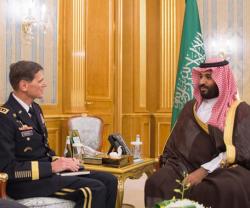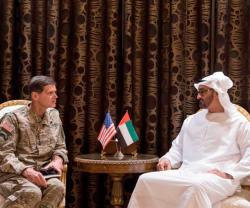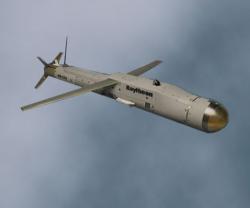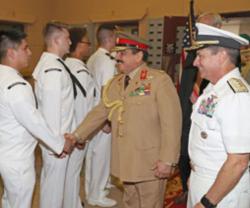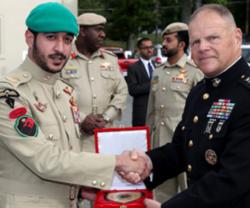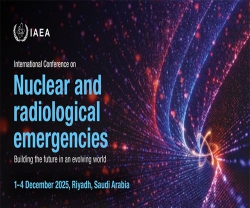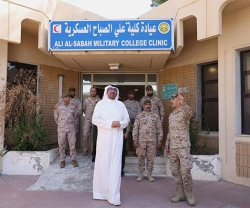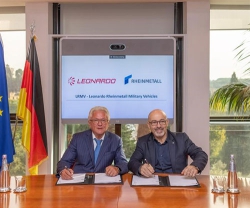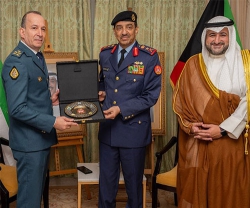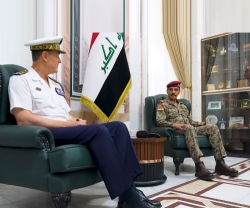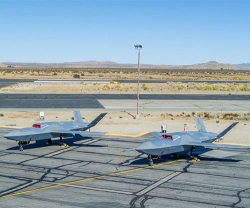Interview: Anatoly Isaykin, Director General, Rosoboronexport
23.08.2013 Russia
“Allegations that pricing of the Russian helicopters supplied to Afghanistan under the contract with the United States of America is too high, are groundless”, says Anatoly Isaykin, Director General of Rosoboronexport
The international media is actively discussing news about the contracts concluded by Rosoboronexport with the US Department of Defense for the supply of the Mi-17V-5 helicopters to the Afghan security forces. Recent debates in the US Congress show that many US Congressmen are on the brink of revolt against the purchase of Russian helicopters. Director General of the joint stock company Rosoboronexport Anatoly Isaykin tells the Interfax-AVN information agency what has provoked such bitter controversy and why the US defence agency continues buying Russian helicopters regardless of the active opposition by the US legislators.
- Anatoly Petrovich, the US press blames you for giving no comments on the situation around the helicopter contracts signed with the US Department of Defense, for your keeping silent and being reluctant to comment. Is it really so? What do you think is the cause of the campaign started up by the US Congressmen?
- The answer is rather simple: heated debates in the US Congress were initiated by lobbyists defending interests of American manufacturers whose helicopters are more expensive than ours. They just did not like that the Pentagon would buy helicopters from Russia, even though not for its own needs but for the Afghan Security Forces. And they would have liked to change the situation in favour of US companies. That's all about it.
As to accusations of our keeping silent, here we follow the iron rule valid for military technical cooperation with our partners in all regions of the world: it is always a buyer country to be the first to divulge information about the procurement of weapons and military equipment and certain terms of contracts. It is the buyer’s exclusive right.
Besides, nowadays one can find information on the contract with the Pentagon in the internet where the corresponding official press releases have been placed. Thus the Russian side does not go into information underground nor avoids contacts with media. Our meeting with you is another proof of this.
- Will you then explain why the Pentagon would buy the Mi-17 Russian helicopters and not, for example, the US Black Hawks?
- I reckon this question should be better asked of the US military. As they have already explained, the Mi-17s are less expensive and simpler to maintain than their American counterparts. Let me refer to a statement that one Pentagon representative made to the media: “There will be an urgent need to procure the Mi-17s in the near future for an air wing created in Afghanistan since this helicopter is optimal for carrying out tasks assigned to this unit”.
Moreover, in the opinion of high-ranking US Officers the procurement of the Mi-17 Russian helicopters for the Afghan Security Forces corresponds with US national interests. This purchase is part of a wider program of the United States and International Security Assistance Forces (ISAF) designed to beef up the capabilities and potential of the Afghan National Security Forces.
The Pentagon has repeatedly stated that the Russian Mi-17s are best of all suited for operations in Afghanistan, and local pilots are well familiar with controls in Mil helicopters. There is no way that they will be able to quickly master more complex US helicopters. On the other hand, the US troops making part of the ISAF are scheduled to leave Afghanistan soon, according to media reports.
- Many Congressmen disagree with these reasons. Moreover, they accuse the Russian side of overpricing the Mi-17 helicopters linking this to corruption, and say they oppose Rosboronexport’s getting rich with the US taxpayer money. Besides, they do not like that the Pentagon has not invited bids for the contract. What would you say to this?
- First of all, I’d say that figures on price parameters of this transaction disclosed by some respected US newspapers and Congressmen are often incorrect. As well as are references to unverified sources whose competence in questions of military-purpose product price formation is inadequate, to say the least. But the whole point is that besides delivery of the aircraft arms trade contracts also stipulate supplies of spare parts and ground support equipment, as well as rendering of logistic support and other services. It is unclear how journalists may determine a helicopter unit price without knowing how it has been formed. But then we know that sometimes the media compares the contractual cost of the Mi-17 helicopters supplied to Afghanistan with the budget of a procurement programme for a much smaller quantity of the US AH-64D Apache/Longbow attack helicopters that are not actual analogues of the Mi-17 type helicopters designed to perform different missions.
In reality such publications are vestiges of so called “war of nerves” waged in the arms sales market. It is also an outcome of activities undertaken by the lobbyists in the US Congress. But when price levels of the Mi-17 helicopter are compared with those of its counterparts, the Russian air vehicle comes out with considerably higher cost-effectiveness than its competitors. One arrives at such a conclusion when comparing, for instance, the Mi-17 with UH-60 Black Hawk helicopters. The Black Hawk is inferior to the Mi-17 as regards load capacity, cargo compartment volume and maximum flight altitude. The Black Hawk carries two times less landing troops than our Mi-17 can. But the price of the US helicopter is markedly higher than that of the Mi-17V-5. I give no exact figures because Congressmen know them well as it is. And, by the way, this issue is openly discussed in the USA, although not so outspoken.
Secondly, Rosoboronexport does not enrich itself at the expense of the US taxpayers. Talks about this are nothing but provocation. Payments under the helicopter contract signed with the USA go to the Russian enterprises engaged in helicopter production. They make up salaries of people who develop and manufacture these aircraft. And it is normal, isn't it?
I will also comment on why no tender has been open. It is true: there was no tender. But it is this fact that I would single out as the most prominent event in the new history of our bilateral military-political relations. And I’ll tell you why: the first contract for the delivery to Afghanistan of the Mi-17V-5 military transport helicopters signed between the JSC Rosoboronexport and US Government in May 2011 was a milestone for the authorities of two Great Powers, the United States and Russia, marking the new stage in the interstate relations.
It may sound pathetic but one can hardly put it otherwise: thanks to this contract the notions of common national interests, mutual economic benefits and complete legitimacy of this interstate transaction have acquired a new reading in the Russian-American relations. These are symbols of a real policy aimed at solving the common international problem connected with the situation in Afghanistan. Many congressmen see this perfectly well. But for some reasons they speak of things of which they themselves seem to be not so sure.
- Can you tell us about negotiations with the Americans?
- First I must say that during all talks within the Russian and American delegations there were representatives of the Federal Service for military technical cooperation and Ministry of Defence of Russia, the US Department of Defense and the US Government. Their participation constantly underlined the importance of this project for both sides. In these talks the US party showed themselves as excellent negotiators, tenacious and well-prepared experts of the highest class. Each meeting we had was very interesting.
They proved to be excellent guys, as Americans say, and extremely competent officers who knew well not only, so to say, hardware but also value for money and how to bargain over each cent. It was pleasure to work with them from all points of view, including a purely professional one.
In particular, the Americans meticulously studied all issues of price formation without any exception, and decomposed the price structure of each helicopter. We discussed absolutely all parameters affecting the cost of a separate helicopter: its production, insurance, maintenance, delivery, personnel training, installation of additional Western equipment required for Afghan crews, as well as many other issues.
- But why did the Pentagon turn to Rosoboronexport if Americans had previously bought Mil helicopters from other suppliers?
- Everything is simple: the contract signed in 2011 between Rosoboronexport, Russia's sole arms trade company entitled to export military-purpose equipment, and the US Government, which is now being successfully and absolutely legally implemented, left no chances to return to unofficial ways of purchasing Mil type helicopters by US companies practised before May 26, 2011.
It must be noted that this way selected by Americans themselves was the only correct one. This is how intergovernmental military technical cooperation should be done. The contract in effect with the USA is characterized by a civilized approach to military sales as well as strict observance of contractual obligations assumed and legislations of both countries. Previously, that is before May 26, 2011, some unscrupulous companies bought civil helicopters from unknown firms via chains of intermediaries and then upgraded them somewhere in third countries. Only after such alleged "modernization" helicopters were delivered to end users. It is difficult to say how much they cost at the end of the day, which is not so important after all. What matters more here is that those aircraft were uncertificated which I would not recommend anybody to fly. And all the more I would not recommend employing them in the struggle with terrorists.
Whereas now everything is clear, transparent and predictable: the US side purchases in Russia high-quality products - the Mi-17V-5 military transport helicopters, most reliable in the world and certificated according to all rules of the international arms market. This undoubtedly brings direct profits to a series manufacturing plant - the Kazan helicopter plant, as well as to the developer of the Mil type helicopters - Moscow helicopter plant, which receive solid money under the US contracts.
- But what is still the real price of one Mi-17 helicopter?
- The answer to this question is in the competence of the US side. I can say only that the Pentagon buys them for a very good and advantageous price. And all allegations that pricing of the Russian helicopters is too high are groundless. This is a disinformation which was most likely sponsored, as I told before, by other helicopter companies wishing to supply their products to Afghanistan. Such allegations are the first-class signs of unfair competition. To such arguments, if one may call them so, resort those who have no solid, logical and factually substantiated arguments.
- How many helicopters are to be supplied under contracts signed with the USA?
- After successful completion of the first contract signed with the Pentagon in May 2011 for the delivery of 21 Mi-17V-5 military transport helicopters, the US Government and Rosoboronexport in 2012 -2013 additionally signed a number of agreements for the delivery of another 42 helicopters. The delivery of the above helicopters will be started in late August 2013 and completed in 2014.
These contracts stipulate that the helicopter systems shall be supplied in the military transport configuration with almost two dozen items of advanced Western-made radio navigation equipment integrated onboard.
- What equipment do you mean?
- I am speaking of special military equipment made in a number of Western countries and for that reason until then prohibited from being imported into the Russian Federation. We had to do lots of legal work to obtain approvals at all possible levels for importing this special items into Russia. But I cannot divulge any more technical details and nuances since there are commercial secrets. I can only add that during the implementation of our contractual obligations we have practised integrated approach and provided direct supplies of the Russian multifunctional military transport helicopters equipped with foreign-made avionics from the manufacturing plant in the interests of the US Department of Defense. This is a very important feature, and probably even a major one, of this contract.
The contract is also distinguished by the fact that after examining the airworthiness confirmation procedures effective in Russia for the Mi-17V-5 helicopters, the US specialists handed over to the Russian Ministry of Defence in Huntsville, USA, a certificate for the acceptance of airworthiness guarantee and maintenance procedures with respect to helicopter technology. You will agree that this also means a lot.
- What missions must these helicopters perform in Afghanistan, according to the customer?
- Tactically there are plenty of missions, but there is only one strategic – to help Afghan people live in peace.
In brief it can be said that the Mi-17 type Russian military transport helicopters are capable of carrying out combat and humanitarian missions, day and night, in fair and adverse weather conditions, and if need be - delivering all available weapons. In general, these new helicopters can be rightly considered one of the symbols of the domestic helicopter industry. Many specialists in different countries acknowledge that these helicopters are the best in their class, being successfully operated in more than 70 countries in different climatic zones.
It is also common knowledge that the Mi-17 efficiently combines advanced technologies invented by Russian designers with vast operational experience gained by their predecessors in wars, local conflicts and peacekeeping operations. The Mi-17 helicopters have inherited unique survivability features of their predecessors which participated in nearly all conflicts in the second half of the 20th century. Soviet helicopters performed well also in Afghanistan where legends ran about their reliability and robustness …
So I would like to again emphasize that presently the Mi-17 helicopter has no rivals as regards cost-effectiveness. Firstly, the Russian helicopters have much lower price than their counterparts. Secondly, the capabilities of the Mi-17 helicopters make them ideally suited for operations in most complex conditions of Afghanistan. Thirdly, it proves much easier to train Afghan crews in the Mi-17 helicopters, to maintain them, and so forth.
Therefore summing up the situation I’d say that the conclusion of the Mi-17 contract was a most pragmatic, balanced and the only correct decision taken by the US Department of Defense, and a clear proof of the fact that our countries can cooperate in solving global problems, pushing aside Cold War prejudices. In fact Russia and the United States have few bilateral projects of such magnitude. And nobody knows how many projects of this kind there will be in future. So we should highly value an unprecedented level of confidence achieved during the helicopter contract implementation.
- And who will be maintaining the helicopters bought by the Pentagon in Afghanistan?
- At present the Russian side has sent to the ISAF base in Kabul a group of specialists from the helicopter production plant to fulfil guarantee obligations. Subsequently the helicopters will be serviced by Afghan technicians. It should be added that Afghan specialists will be fully trained by the time when the contracted helicopters have been delivered. The training process is planned so that the helicopters would not sit idle on runways but fly immediately on their arrival in Afghanistan. The more so that Officers of the US Department of Defense who attended classes in Novosibirsk valued high the quality of Afghan specialist training in Russia. I am absolutely positive that upon completion of a three-to-four-month training programme in Russia Afghan specialists will be able to perform all jobs required of them, and will perform them efficiently. I do not doubt that all Mi-17V-5 helicopters supplied to Afghanistan will be served in good time and in accordance with all operational requirements. I am also certain that Mil helicopters will be flying for many years in the Afghanistan sky, helping its people to solve difficult problems and restore that country's peaceful life. Well, incidentally this is what two strategic partners, Russia and the USA, are striving for. So, returning to the starting point of our conversation, if some in the USA are not happy with this mutually beneficial intergovernmental contract that demonstrates the US interest in Russian technologies for Afghanistan and, generally speaking, in cooperation with Russia over Afghanistan, well, this is no longer our problem.
The international media is actively discussing news about the contracts concluded by Rosoboronexport with the US Department of Defense for the supply of the Mi-17V-5 helicopters to the Afghan security forces. Recent debates in the US Congress show that many US Congressmen are on the brink of revolt against the purchase of Russian helicopters. Director General of the joint stock company Rosoboronexport Anatoly Isaykin tells the Interfax-AVN information agency what has provoked such bitter controversy and why the US defence agency continues buying Russian helicopters regardless of the active opposition by the US legislators.
- Anatoly Petrovich, the US press blames you for giving no comments on the situation around the helicopter contracts signed with the US Department of Defense, for your keeping silent and being reluctant to comment. Is it really so? What do you think is the cause of the campaign started up by the US Congressmen?
- The answer is rather simple: heated debates in the US Congress were initiated by lobbyists defending interests of American manufacturers whose helicopters are more expensive than ours. They just did not like that the Pentagon would buy helicopters from Russia, even though not for its own needs but for the Afghan Security Forces. And they would have liked to change the situation in favour of US companies. That's all about it.
As to accusations of our keeping silent, here we follow the iron rule valid for military technical cooperation with our partners in all regions of the world: it is always a buyer country to be the first to divulge information about the procurement of weapons and military equipment and certain terms of contracts. It is the buyer’s exclusive right.
Besides, nowadays one can find information on the contract with the Pentagon in the internet where the corresponding official press releases have been placed. Thus the Russian side does not go into information underground nor avoids contacts with media. Our meeting with you is another proof of this.
- Will you then explain why the Pentagon would buy the Mi-17 Russian helicopters and not, for example, the US Black Hawks?
- I reckon this question should be better asked of the US military. As they have already explained, the Mi-17s are less expensive and simpler to maintain than their American counterparts. Let me refer to a statement that one Pentagon representative made to the media: “There will be an urgent need to procure the Mi-17s in the near future for an air wing created in Afghanistan since this helicopter is optimal for carrying out tasks assigned to this unit”.
Moreover, in the opinion of high-ranking US Officers the procurement of the Mi-17 Russian helicopters for the Afghan Security Forces corresponds with US national interests. This purchase is part of a wider program of the United States and International Security Assistance Forces (ISAF) designed to beef up the capabilities and potential of the Afghan National Security Forces.
The Pentagon has repeatedly stated that the Russian Mi-17s are best of all suited for operations in Afghanistan, and local pilots are well familiar with controls in Mil helicopters. There is no way that they will be able to quickly master more complex US helicopters. On the other hand, the US troops making part of the ISAF are scheduled to leave Afghanistan soon, according to media reports.
- Many Congressmen disagree with these reasons. Moreover, they accuse the Russian side of overpricing the Mi-17 helicopters linking this to corruption, and say they oppose Rosboronexport’s getting rich with the US taxpayer money. Besides, they do not like that the Pentagon has not invited bids for the contract. What would you say to this?
- First of all, I’d say that figures on price parameters of this transaction disclosed by some respected US newspapers and Congressmen are often incorrect. As well as are references to unverified sources whose competence in questions of military-purpose product price formation is inadequate, to say the least. But the whole point is that besides delivery of the aircraft arms trade contracts also stipulate supplies of spare parts and ground support equipment, as well as rendering of logistic support and other services. It is unclear how journalists may determine a helicopter unit price without knowing how it has been formed. But then we know that sometimes the media compares the contractual cost of the Mi-17 helicopters supplied to Afghanistan with the budget of a procurement programme for a much smaller quantity of the US AH-64D Apache/Longbow attack helicopters that are not actual analogues of the Mi-17 type helicopters designed to perform different missions.
In reality such publications are vestiges of so called “war of nerves” waged in the arms sales market. It is also an outcome of activities undertaken by the lobbyists in the US Congress. But when price levels of the Mi-17 helicopter are compared with those of its counterparts, the Russian air vehicle comes out with considerably higher cost-effectiveness than its competitors. One arrives at such a conclusion when comparing, for instance, the Mi-17 with UH-60 Black Hawk helicopters. The Black Hawk is inferior to the Mi-17 as regards load capacity, cargo compartment volume and maximum flight altitude. The Black Hawk carries two times less landing troops than our Mi-17 can. But the price of the US helicopter is markedly higher than that of the Mi-17V-5. I give no exact figures because Congressmen know them well as it is. And, by the way, this issue is openly discussed in the USA, although not so outspoken.
Secondly, Rosoboronexport does not enrich itself at the expense of the US taxpayers. Talks about this are nothing but provocation. Payments under the helicopter contract signed with the USA go to the Russian enterprises engaged in helicopter production. They make up salaries of people who develop and manufacture these aircraft. And it is normal, isn't it?
I will also comment on why no tender has been open. It is true: there was no tender. But it is this fact that I would single out as the most prominent event in the new history of our bilateral military-political relations. And I’ll tell you why: the first contract for the delivery to Afghanistan of the Mi-17V-5 military transport helicopters signed between the JSC Rosoboronexport and US Government in May 2011 was a milestone for the authorities of two Great Powers, the United States and Russia, marking the new stage in the interstate relations.
It may sound pathetic but one can hardly put it otherwise: thanks to this contract the notions of common national interests, mutual economic benefits and complete legitimacy of this interstate transaction have acquired a new reading in the Russian-American relations. These are symbols of a real policy aimed at solving the common international problem connected with the situation in Afghanistan. Many congressmen see this perfectly well. But for some reasons they speak of things of which they themselves seem to be not so sure.
- Can you tell us about negotiations with the Americans?
- First I must say that during all talks within the Russian and American delegations there were representatives of the Federal Service for military technical cooperation and Ministry of Defence of Russia, the US Department of Defense and the US Government. Their participation constantly underlined the importance of this project for both sides. In these talks the US party showed themselves as excellent negotiators, tenacious and well-prepared experts of the highest class. Each meeting we had was very interesting.
They proved to be excellent guys, as Americans say, and extremely competent officers who knew well not only, so to say, hardware but also value for money and how to bargain over each cent. It was pleasure to work with them from all points of view, including a purely professional one.
In particular, the Americans meticulously studied all issues of price formation without any exception, and decomposed the price structure of each helicopter. We discussed absolutely all parameters affecting the cost of a separate helicopter: its production, insurance, maintenance, delivery, personnel training, installation of additional Western equipment required for Afghan crews, as well as many other issues.
- But why did the Pentagon turn to Rosoboronexport if Americans had previously bought Mil helicopters from other suppliers?
- Everything is simple: the contract signed in 2011 between Rosoboronexport, Russia's sole arms trade company entitled to export military-purpose equipment, and the US Government, which is now being successfully and absolutely legally implemented, left no chances to return to unofficial ways of purchasing Mil type helicopters by US companies practised before May 26, 2011.
It must be noted that this way selected by Americans themselves was the only correct one. This is how intergovernmental military technical cooperation should be done. The contract in effect with the USA is characterized by a civilized approach to military sales as well as strict observance of contractual obligations assumed and legislations of both countries. Previously, that is before May 26, 2011, some unscrupulous companies bought civil helicopters from unknown firms via chains of intermediaries and then upgraded them somewhere in third countries. Only after such alleged "modernization" helicopters were delivered to end users. It is difficult to say how much they cost at the end of the day, which is not so important after all. What matters more here is that those aircraft were uncertificated which I would not recommend anybody to fly. And all the more I would not recommend employing them in the struggle with terrorists.
Whereas now everything is clear, transparent and predictable: the US side purchases in Russia high-quality products - the Mi-17V-5 military transport helicopters, most reliable in the world and certificated according to all rules of the international arms market. This undoubtedly brings direct profits to a series manufacturing plant - the Kazan helicopter plant, as well as to the developer of the Mil type helicopters - Moscow helicopter plant, which receive solid money under the US contracts.
- But what is still the real price of one Mi-17 helicopter?
- The answer to this question is in the competence of the US side. I can say only that the Pentagon buys them for a very good and advantageous price. And all allegations that pricing of the Russian helicopters is too high are groundless. This is a disinformation which was most likely sponsored, as I told before, by other helicopter companies wishing to supply their products to Afghanistan. Such allegations are the first-class signs of unfair competition. To such arguments, if one may call them so, resort those who have no solid, logical and factually substantiated arguments.
- How many helicopters are to be supplied under contracts signed with the USA?
- After successful completion of the first contract signed with the Pentagon in May 2011 for the delivery of 21 Mi-17V-5 military transport helicopters, the US Government and Rosoboronexport in 2012 -2013 additionally signed a number of agreements for the delivery of another 42 helicopters. The delivery of the above helicopters will be started in late August 2013 and completed in 2014.
These contracts stipulate that the helicopter systems shall be supplied in the military transport configuration with almost two dozen items of advanced Western-made radio navigation equipment integrated onboard.
- What equipment do you mean?
- I am speaking of special military equipment made in a number of Western countries and for that reason until then prohibited from being imported into the Russian Federation. We had to do lots of legal work to obtain approvals at all possible levels for importing this special items into Russia. But I cannot divulge any more technical details and nuances since there are commercial secrets. I can only add that during the implementation of our contractual obligations we have practised integrated approach and provided direct supplies of the Russian multifunctional military transport helicopters equipped with foreign-made avionics from the manufacturing plant in the interests of the US Department of Defense. This is a very important feature, and probably even a major one, of this contract.
The contract is also distinguished by the fact that after examining the airworthiness confirmation procedures effective in Russia for the Mi-17V-5 helicopters, the US specialists handed over to the Russian Ministry of Defence in Huntsville, USA, a certificate for the acceptance of airworthiness guarantee and maintenance procedures with respect to helicopter technology. You will agree that this also means a lot.
- What missions must these helicopters perform in Afghanistan, according to the customer?
- Tactically there are plenty of missions, but there is only one strategic – to help Afghan people live in peace.
In brief it can be said that the Mi-17 type Russian military transport helicopters are capable of carrying out combat and humanitarian missions, day and night, in fair and adverse weather conditions, and if need be - delivering all available weapons. In general, these new helicopters can be rightly considered one of the symbols of the domestic helicopter industry. Many specialists in different countries acknowledge that these helicopters are the best in their class, being successfully operated in more than 70 countries in different climatic zones.
It is also common knowledge that the Mi-17 efficiently combines advanced technologies invented by Russian designers with vast operational experience gained by their predecessors in wars, local conflicts and peacekeeping operations. The Mi-17 helicopters have inherited unique survivability features of their predecessors which participated in nearly all conflicts in the second half of the 20th century. Soviet helicopters performed well also in Afghanistan where legends ran about their reliability and robustness …
So I would like to again emphasize that presently the Mi-17 helicopter has no rivals as regards cost-effectiveness. Firstly, the Russian helicopters have much lower price than their counterparts. Secondly, the capabilities of the Mi-17 helicopters make them ideally suited for operations in most complex conditions of Afghanistan. Thirdly, it proves much easier to train Afghan crews in the Mi-17 helicopters, to maintain them, and so forth.
Therefore summing up the situation I’d say that the conclusion of the Mi-17 contract was a most pragmatic, balanced and the only correct decision taken by the US Department of Defense, and a clear proof of the fact that our countries can cooperate in solving global problems, pushing aside Cold War prejudices. In fact Russia and the United States have few bilateral projects of such magnitude. And nobody knows how many projects of this kind there will be in future. So we should highly value an unprecedented level of confidence achieved during the helicopter contract implementation.
- And who will be maintaining the helicopters bought by the Pentagon in Afghanistan?
- At present the Russian side has sent to the ISAF base in Kabul a group of specialists from the helicopter production plant to fulfil guarantee obligations. Subsequently the helicopters will be serviced by Afghan technicians. It should be added that Afghan specialists will be fully trained by the time when the contracted helicopters have been delivered. The training process is planned so that the helicopters would not sit idle on runways but fly immediately on their arrival in Afghanistan. The more so that Officers of the US Department of Defense who attended classes in Novosibirsk valued high the quality of Afghan specialist training in Russia. I am absolutely positive that upon completion of a three-to-four-month training programme in Russia Afghan specialists will be able to perform all jobs required of them, and will perform them efficiently. I do not doubt that all Mi-17V-5 helicopters supplied to Afghanistan will be served in good time and in accordance with all operational requirements. I am also certain that Mil helicopters will be flying for many years in the Afghanistan sky, helping its people to solve difficult problems and restore that country's peaceful life. Well, incidentally this is what two strategic partners, Russia and the USA, are striving for. So, returning to the starting point of our conversation, if some in the USA are not happy with this mutually beneficial intergovernmental contract that demonstrates the US interest in Russian technologies for Afghanistan and, generally speaking, in cooperation with Russia over Afghanistan, well, this is no longer our problem.
Latest news
Latest events
Dubai International Air Chiefs’ Conference (DIACC 2025)
16 Nov 2025Atlantis, The Palm Dubai - United Arab EmiratesDubai Airshow
17 - 21 Nov 2025Dubai World Central (DWC) - United Arab EmiratesEgypt Defence Expo (EDEX)
01 - 04 Dec 2025Egypt International Exhibition Center New Cairo - EgyptDoha International Maritime Defence Exhibition & Conference (DIMDEX 2026)
19 - 22 Jan 2026Doha - Qatar


